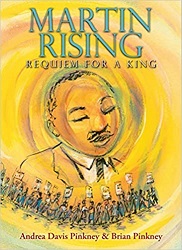
 Martin Rising
Martin RisingRequiem for a King
Scholastic Press, January 2018. 128 pages.
Starred Review
2018 Sonderbooks Stand-out:
#9 Longer Children's Nonfiction
I’m writing this review on Martin Luther King, Jr.’s birthday in 2018. It’s a shame I can’t post it today, but I have to remain silent online about any 2018 children’s books until after we announce our Newbery winners.
This book is poetry combined with art, telling about the events that happened 50 years ago in 1968, the last months of Martin’s life.
I have to confess I’m not the best audience for unrhymed poetry. I haven’t spoken with anyone else yet about this book, and I have a feeling that when I do, others will be able to point out details of the craft that went right by me.
But what we have here is history in the form of poetry. There is symbolism – a progression from daylight to darkness to dawn. Some more symbolism that even I could catch was in a poem about forcing forsythia to bloom where that’s compared with forcing garbage collectors in Tennessee to do degrading work in harsh conditions. March is said to come in like a lion – but no progress is made, and it leaves much more quietly.
And the event that sparks the chain of events in this book was the death of two sanitation workers in Memphis, Tennessee, and the protests that sparked. There are lots of facts here – you’ll learn about what happened, along with the dignity and nobility of those who protested.
(I’m now going to pause and reread the book as a fitting way of celebrating Martin Luther King’s birthday.)
Here are some good bits:
In the poem “Come: February 24, 1968”:
But, Lord,
even with your handiwork
hard at work,
it is hard, hard work
not to strike back violently,
especially when you’re striking.
In the poem “Roar! March 11, 1968”:
These strikers have volunteered for
peaceful protest.
When the police handcuff
and shove them,
and choke hold their hope,
and cart them away,
these men and women,
and girls and boys
who have volunteered
for self-dignity,
will not
enter jail
in the same way
March
enters the calendar.
These strong, quiet
strikers,
and all who stand by them
refuse to Roar.
Going out like lambs,
they are ignored.
From the final poem, “Rejoice the Legacy: January 15 – Martin Luther King Day – Forever”:
And so, today, though his candles stopped
at thirty-nine,
we celebrate Martin’s exquisite life.
His sparkling-eyed vision
of tomorrow’s promise.
His destiny.
His dream.
How he led us to the mountaintop
on the path of light, love, and truth.
He didn’t get there with us.
But he showed us the way.
So that’s this book – a poetic tribute to Martin Luther King’s life and the story of his final months. I love the suggestion in the author’s note at the back to perform these as a group reading or as a classroom play. It is all too easy to rush through these poems. I’m pretty sure that the harder I look at them, the more riches I’ll find.
